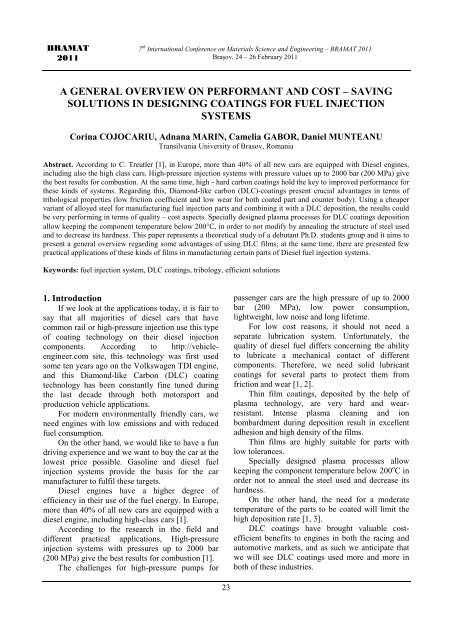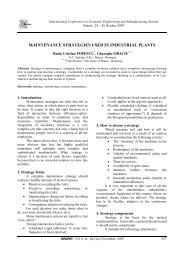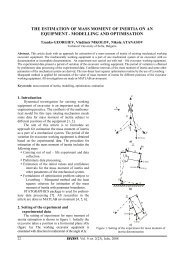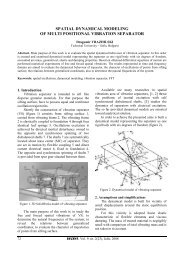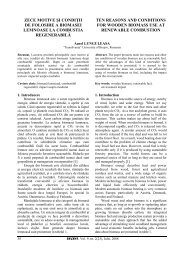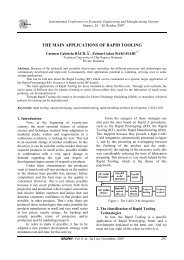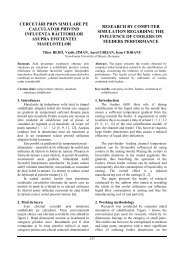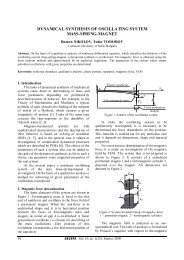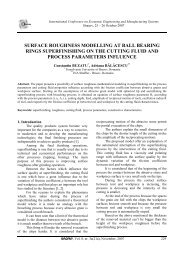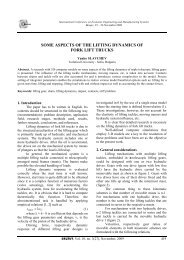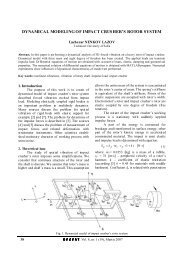saving solutions in designing coatings for fuel injection systems
saving solutions in designing coatings for fuel injection systems
saving solutions in designing coatings for fuel injection systems
Create successful ePaper yourself
Turn your PDF publications into a flip-book with our unique Google optimized e-Paper software.
BRAMAT20117 th International Conference on Materials Science and Eng<strong>in</strong>eer<strong>in</strong>g – BRAMAT 2011Braşov, 24 – 26 February 2011A GENERAL OVERVIEW ON PERFORMANT AND COST – SAVINGSOLUTIONS IN DESIGNING COATINGS FOR FUEL INJECTIONSYSTEMSCor<strong>in</strong>a COJOCARIU, Adnana MARIN, Camelia GABOR, Daniel MUNTEANUTransilvania University of Brasov, RomaniaAbstract. Accord<strong>in</strong>g to C. Treutler [1], <strong>in</strong> Europe, more than 40% of all new cars are equipped with Diesel eng<strong>in</strong>es,<strong>in</strong>clud<strong>in</strong>g also the high class cars. High-pressure <strong>in</strong>jection <strong>systems</strong> with pressure values up to 2000 bar (200 MPa) givethe best results <strong>for</strong> combustion. At the same time, high - hard carbon coat<strong>in</strong>gs hold the key to improved per<strong>for</strong>mance <strong>for</strong>these k<strong>in</strong>ds of <strong>systems</strong>. Regard<strong>in</strong>g this, Diamond-like carbon (DLC)-coat<strong>in</strong>gs present crucial advantages <strong>in</strong> terms oftribological properties (low friction coefficient and low wear <strong>for</strong> both coated part and counter body). Us<strong>in</strong>g a cheapervariant of alloyed steel <strong>for</strong> manufactur<strong>in</strong>g <strong>fuel</strong> <strong>in</strong>jection parts and comb<strong>in</strong><strong>in</strong>g it with a DLC deposition, the results couldbe very per<strong>for</strong>m<strong>in</strong>g <strong>in</strong> terms of quality – cost aspects. Specially designed plasma processes <strong>for</strong> DLC coat<strong>in</strong>gs depositionallow keep<strong>in</strong>g the component temperature below 200°C, <strong>in</strong> order to not modify by anneal<strong>in</strong>g the structure of steel usedand to decrease its hardness. This paper represents a theoretical study of a debutant Ph.D. students group and it aims topresent a general overview regard<strong>in</strong>g some advantages of us<strong>in</strong>g DLC films; at the same time, there are presented fewpractical applications of these k<strong>in</strong>ds of films <strong>in</strong> manufactur<strong>in</strong>g certa<strong>in</strong> parts of Diesel <strong>fuel</strong> <strong>in</strong>jection <strong>systems</strong>.Keywords: <strong>fuel</strong> <strong>in</strong>jection system, DLC coat<strong>in</strong>gs, tribology, efficient <strong>solutions</strong>1. IntroductionIf we look at the applications today, it is fair tosay that all majorities of diesel cars that havecommon rail or high-pressure <strong>in</strong>jection use this typeof coat<strong>in</strong>g technology on their diesel <strong>in</strong>jectioncomponents. Accord<strong>in</strong>g to http://vehicleeng<strong>in</strong>eer.comsite, this technology was first usedsome ten years ago on the Volkswagen TDI eng<strong>in</strong>e,and this Diamond-like Carbon (DLC) coat<strong>in</strong>gtechnology has been constantly f<strong>in</strong>e tuned dur<strong>in</strong>gthe last decade through both motorsport andproduction vehicle applications.For modern environmentally friendly cars, weneed eng<strong>in</strong>es with low emissions and with reduced<strong>fuel</strong> consumption.On the other hand, we would like to have a fundriv<strong>in</strong>g experience and we want to buy the car at thelowest price possible. Gasol<strong>in</strong>e and diesel <strong>fuel</strong><strong>in</strong>jection <strong>systems</strong> provide the basis <strong>for</strong> the carmanufacturer to fulfil these targets.Diesel eng<strong>in</strong>es have a higher degree ofefficiency <strong>in</strong> their use of the <strong>fuel</strong> energy. In Europe,more than 40% of all new cars are equipped with adiesel eng<strong>in</strong>e, <strong>in</strong>clud<strong>in</strong>g high-class cars [1].Accord<strong>in</strong>g to the research <strong>in</strong> the field anddifferent practical applications, High-pressure<strong>in</strong>jection <strong>systems</strong> with pressures up to 2000 bar(200 MPa) give the best results <strong>for</strong> combustion [1].The challenges <strong>for</strong> high-pressure pumps <strong>for</strong>passenger cars are the high pressure of up to 2000bar (200 MPa), low power consumption,lightweight, low noise and long lifetime.For low cost reasons, it should not need aseparate lubrication system. Un<strong>for</strong>tunately, thequality of diesel <strong>fuel</strong> differs concern<strong>in</strong>g the abilityto lubricate a mechanical contact of differentcomponents. There<strong>for</strong>e, we need solid lubricantcoat<strong>in</strong>gs <strong>for</strong> several parts to protect them fromfriction and wear [1, 2].Th<strong>in</strong> film coat<strong>in</strong>gs, deposited by the help ofplasma technology, are very hard and wearresistant.Intense plasma clean<strong>in</strong>g and ionbombardment dur<strong>in</strong>g deposition result <strong>in</strong> excellentadhesion and high density of the films.Th<strong>in</strong> films are highly suitable <strong>for</strong> parts withlow tolerances.Specially designed plasma processes allowkeep<strong>in</strong>g the component temperature below 200 o C <strong>in</strong>order not to anneal the steel used and decrease itshardness.On the other hand, the need <strong>for</strong> a moderatetemperature of the parts to be coated will limit thehigh deposition rate [1, 3].DLC coat<strong>in</strong>gs have brought valuable costefficientbenefits to eng<strong>in</strong>es <strong>in</strong> both the rac<strong>in</strong>g andautomotive markets, and as such we anticipate thatwe will see DLC coat<strong>in</strong>gs used more and more <strong>in</strong>both of these <strong>in</strong>dustries.23
RECENT, Vol. 12, no. 1(31), March, 2011Accord<strong>in</strong>g to C. Treutler [1], <strong>for</strong> the protectionof component parts aga<strong>in</strong>st friction and wear,diamond-like-carbon (DLC)-coat<strong>in</strong>gs show crucialadvantages <strong>in</strong> a low wear, <strong>in</strong> the low coefficient offriction (even <strong>for</strong> a non lubricated contact with steelas counterpart) and <strong>in</strong> the low wear of the counterbody.Hence, <strong>for</strong> example, only the pump pistonneeds to be coated and not the <strong>in</strong>ner surface of thepump cyl<strong>in</strong>der, which would be very difficult.Besides this, the costs <strong>for</strong> the coat<strong>in</strong>g of thecounterpart can be saved [1].Despite the current economic crisis, it isessential <strong>for</strong> the <strong>in</strong>dustry and market leaders to startcontemplat<strong>in</strong>g the recovery [13].These leaders need to determ<strong>in</strong>e how theircompany and products will be profiled dur<strong>in</strong>g therecovery to make sure they are back on track whenbus<strong>in</strong>ess picks up aga<strong>in</strong>.The European Commission has recentlydeveloped a programme to reduce vehicle CO 2emissions, which motor manufacturers must adheretoo. Failure to meet these emission limits will <strong>in</strong> thefuture result <strong>in</strong> f<strong>in</strong>ancial penalties of at least €95 pergram above the limit set by the EC [13].Many studies showed that us<strong>in</strong>g DLC coat<strong>in</strong>gsreduces the friction losses, which translates <strong>in</strong>toreduced consumption and, subsequently, loweremissions. Essentially, this means that DLCcoat<strong>in</strong>gs will be one way to help meet future CO 2limits.PSA Peugeot Citroën (previously PeugeotSociété Anonyme - PSA Group) conducted a test tomeasure the actual value of DLC coat<strong>in</strong>gs <strong>in</strong> thisprocess. It revealed that DLC coat<strong>in</strong>gs applied ontappets reduce overall <strong>fuel</strong> consumption by 1-2%,which equates to a <strong>sav<strong>in</strong>g</strong> of somewhere between 2-3g/km of CO 2 [13].The biggest advantage of DLC coat<strong>in</strong>gs is thatthey reduce CO 2 emissions <strong>in</strong> exist<strong>in</strong>g eng<strong>in</strong>es, sothere is no need <strong>for</strong> a drastic redesign of the eng<strong>in</strong>e.Like an example, tappets can be coated, which canlead to a 1-2% reduction of emissions without aredesign of the valve-tra<strong>in</strong>.Accord<strong>in</strong>g to Mark Boghe [13] (Bekaert DLCcoat<strong>in</strong>gs), if a manufacturer wants to take fulladvantage of this technology, however, thesecoat<strong>in</strong>gs need to be <strong>in</strong>tegrated from the start of thedesign. At the same time, by apply<strong>in</strong>g DLC coat<strong>in</strong>gsto components not only <strong>in</strong>creases the lifetime of thecomponents, but also extends the lifetime of theentire eng<strong>in</strong>e.Consider<strong>in</strong>g a camshaft, by apply<strong>in</strong>g a DLCcoat<strong>in</strong>g, the profile of the cams is protected aga<strong>in</strong>stwear (longer lifetime) but it also guarantees that, aslong as the coat<strong>in</strong>g is applied, the per<strong>for</strong>mance ofthe camshaft is consistent (no gradual deterioration<strong>in</strong> per<strong>for</strong>mance).On the other hand, the emissions outlets sufferbecause the natural by-product of combustion arecarbon deposits. As small, super hard particulatesflow through the filters, they come <strong>in</strong> contact withthe mov<strong>in</strong>g parts and gouge them <strong>in</strong> a significantmanner [13].If these parts are harder than the particulates, theyare crushed and absorbed; DLC coat<strong>in</strong>gs are usuallystronger than whatever goes <strong>in</strong>to the eng<strong>in</strong>e [15].2. Theoretical background on DLC coat<strong>in</strong>gsIn terms of Diamond-like carbon properties, itis often believed that the presence of sp 3 sites is theonly criterion <strong>for</strong> diamond-like properties. This isthe source of much confusion. Many softtransparent polymers conta<strong>in</strong> high sp 3concentrations, but are obviously not considered asdiamond-like [4]. In that case, only the optical gapis similar to that of diamond. In pure diamond, allcarbon atoms reside <strong>in</strong> sp 3 sites, but the importantpo<strong>in</strong>t is that these sites are <strong>in</strong>terl<strong>in</strong>ked by strongcovalent bonds (about 7.02 eV), with no weak cha<strong>in</strong>element (except at a few crystall<strong>in</strong>e po<strong>in</strong>t defects).This is one of the explanations <strong>for</strong> diamond'shardness.In polymers, most of the cha<strong>in</strong>s of covalentbonds are term<strong>in</strong>ated by H atoms (C–H covalentbonds have energies of 4.1 eV <strong>for</strong> H–C sp 3 , 4.5 eV<strong>for</strong> H–C sp 2 , and 5.4 eV <strong>for</strong> H–C sp 1 ). Between thecha<strong>in</strong> elements, discont<strong>in</strong>uities of much lowerb<strong>in</strong>d<strong>in</strong>g energy are produced (hydrogen bonds of adifferent k<strong>in</strong>d than H–C covalent bonds, and vander Waals bonds).This expla<strong>in</strong>s their “plastic” properties. Ingraphite, the carbon atoms reside <strong>in</strong> sp 2 sites, andare <strong>in</strong>terl<strong>in</strong>ked by a higher b<strong>in</strong>d<strong>in</strong>g energy of 7.03eV with<strong>in</strong> the dense plane only, and the fourthelectron of the outer carbon atom electron orbitalcontributes to a weak b<strong>in</strong>d<strong>in</strong>g energy of 0.86 eVbetween planes, expla<strong>in</strong><strong>in</strong>g why it is much softer,and somewhat brittle.An amorphous mixture of exclusively carbonatoms will correspond mostly to sp 3 and sp 2 sites(with a few sp 1 sites), and the local b<strong>in</strong>d<strong>in</strong>g energieswill be distributed around the energies of 7.02, 7.03and 0.86 eV (often reported with an average of 3.6eV) [4].Accord<strong>in</strong>g to the literature, many different24
RECENT, Vol. 12, no. 1(31), March, 2011categories of DLC films have been reported. S.Neuville presents a very professional synthesis ofthese <strong>in</strong> [4]. Accord<strong>in</strong>g to this, the ma<strong>in</strong> groups area-C (non-hydrogenated amorphous carbon), a-C:H(hydrogenated amorphous carbon) and polymeric a-C:H (highly hydrogenated amorphous carbon).With<strong>in</strong> this classification, the concentration of sp 3sites should also be considered. However, as wehave seen above, the sp 3 concentration alone is not asufficient criterion by which to determ<strong>in</strong>e propertydifferences among different amorphous carbontypes, which may have a similar concentration ofsp 3 sites. In practice, the mechanical and physicalproperties are the factors, which def<strong>in</strong>e anddifferentiate DLCs.- Polymeric amorphous carbon. a-C:H type DLCsconta<strong>in</strong><strong>in</strong>g more than 40 at.% hydrogen, are usuallycalled polymeric amorphous carbon materials [4, 5],which are very similar to “plastic” polymers.- Soft graphitic a-C:Hs and a-Cs. Amorphouscarbon films with a majority of sp 2 sites (>90 at.%)have properties close to graphite and a hardnesswhich can be lower than 10 GPa [4, 5, 6].- Hard a-C:H and ta-C. Hydrogenated amorphouscarbon (a-C:H) can reach high hardness (about 50GPa) when the H content is not higher than 20 at.%and they conta<strong>in</strong> a high sp 3 /sp 2 site ratio [5, 7].These films have been considered <strong>for</strong> a long time asvery promis<strong>in</strong>g because of their low frictioncoefficient (e.g., aga<strong>in</strong>st sta<strong>in</strong>less steel) <strong>in</strong> some<strong>in</strong>ert atmospheres [4, 8, 9].- Tetrahedral amorphous carbon and polycrystall<strong>in</strong>ediamond. The differentiation between thepreviously described hard a-C and ta-C can be verysubjective when the carbon sp 3 sites are rarelybonded to other types of atoms and carbon sites,with a low bond<strong>in</strong>g energy. In this case, it is nolonger necessary to consider the difference betweenstrongly bonded sp 3 and weakly bonded sp 3 , s<strong>in</strong>cestrong bonds (expla<strong>in</strong><strong>in</strong>g their hardness as alreadydiscussed) <strong>in</strong>terl<strong>in</strong>k almost all of them. This ispractically the only case where the diamond-likeproperties can be described with the sole criterion ofthe sp 3 concentration. Tetrahedral amorphouscarbon (ta-C) films conta<strong>in</strong> a majority of<strong>in</strong>terconnected sp 3 sites (50 to 100% with hardnessof 70 GPa up to 100 GPa, which is close todiamond) [4, 10]. Polycrystall<strong>in</strong>e diamond iscomposed of crystallites conta<strong>in</strong><strong>in</strong>g nearly 100%sp 3 . They have hardness close to bulk diamond.Accord<strong>in</strong>g to S. Neuville at al., ta-C films areable to support higher levels of stress, <strong>in</strong> an elasticstate, without fatigue effects lead<strong>in</strong>g to materialfailure. This is because the yield stress is higherthan conventional DLCs; this benefit is only ofvalue as long as the coat<strong>in</strong>g can accommodate thesubstrate de<strong>for</strong>mation without debond<strong>in</strong>g and aslong as no cohesive crack<strong>in</strong>g or delam<strong>in</strong>ation of thecoat<strong>in</strong>g or substrate occurs, (e.g., when the surfaceis subjected to the Hertzian contact pressures andshear<strong>in</strong>g <strong>for</strong>ces usually encountered <strong>in</strong> practicalcontacts) [4].When the substrate material de<strong>for</strong>ms, then thestress distribution is modified at the coat<strong>in</strong>g–substrate <strong>in</strong>terface and <strong>in</strong> the film material.For this reason, different research programstried to f<strong>in</strong>d <strong>solutions</strong> <strong>for</strong> decreas<strong>in</strong>g gradient ofproperties between surface (DLC layer) andsubstrate and design properly the whole system:substrate – <strong>in</strong>terface – film (figure 1). Table 1presents 2 <strong>solutions</strong> founded by Bosch, <strong>in</strong> the caseof DLC coat<strong>in</strong>gs deposited on certa<strong>in</strong> <strong>fuel</strong> <strong>in</strong>jectionparts [1].DLC coat<strong>in</strong>gIntermediate (gradient) layerAdhesion layersubstrateFigure 1. Schematic arrangement of a DLC superficialsystem with gradient of propertiesTable 1. Substrate improv<strong>in</strong>g variants of load capacity ofDLC coat<strong>in</strong>gs [1]System A. B.FunctionallayerIntermediatelayerAdhesionlayerDLC (free ofmetal)C layer/WC/CrChromiumDLC (free ofmetal)CrCChromiumSubstrate Steel SteelThe tribological properties of DLC coat<strong>in</strong>gs donot depend only on the type of coat<strong>in</strong>g, but also onwork<strong>in</strong>g conditions or contact parameters. Becauseof that coefficient of friction depends on thecoat<strong>in</strong>g’s thermal stability, which is subject to their,as well as on atmosphere <strong>in</strong> which coat<strong>in</strong>g isoperat<strong>in</strong>g.One very important factor <strong>in</strong> DLC coat<strong>in</strong>gsper<strong>for</strong>mance is also humidity and the type of gas <strong>in</strong>25
RECENT, Vol. 12, no. 1(31), March, 2011which coat<strong>in</strong>g is operat<strong>in</strong>g [11].Accord<strong>in</strong>g to M. Sedlakek at al., dop<strong>in</strong>g ofDLC coat<strong>in</strong>g with different metals (Ti, Nb, Ta, Cr,Mo, W, Ru, Fe, Co, Ni, Al, Cu and Ag) leads tochanges <strong>in</strong> their mechanical properties (lower<strong>in</strong>ternal stress and hardness, improved adhesion) aswell as <strong>in</strong> their tribological properties, which ma<strong>in</strong>lyreflect <strong>in</strong> decrease of atmosphere dependence [11].Several methods have been developed <strong>for</strong>produc<strong>in</strong>g diamond-like carbon films.Plasma Enhanced (assisted) CVD techniques(PECVD) employ<strong>in</strong>g RF and DC glow discharges<strong>in</strong> hydrocarbon gas mixtures produce smoothamorphous carbon and hydrocarbon films (ontosubstrates negatively biased), which have mixed sp 2and sp 3 bonds. The CVD processes will generallyrequire deposition temperatures of at least 600°C togive the required comb<strong>in</strong>ation of properties;however, low temperature deposition is possible.The CVD technique gives good deposition rates andvery uni<strong>for</strong>m coat<strong>in</strong>gs, and is suited to very largescaleproduction. High-power pulsed-DC sourcesmay use as an alternative of r.f. PECVD method.Pulsed-DC PECVD technologies provide higherdeposition rates, DLC films with high adherence,and do not require match<strong>in</strong>g networks, result<strong>in</strong>g <strong>in</strong> areduction of production cost.Another technique <strong>for</strong> DLC deposition is basedon Ion Beam deposition. This has the advantage ofbe<strong>in</strong>g able to deposit high quality coat<strong>in</strong>gs at verylow temperatures (near room temperature).The Closed Field Unbalanced MagnetronSputter Ion Plat<strong>in</strong>g Process, is a technique that canreadily apply a-C:H films (> 4 µm) to substrates ofany shape. The process is based on closed fieldunbalanced magnetron sputter ion plat<strong>in</strong>g,comb<strong>in</strong>ed with plasma assisted chemical vapourdeposition.The new technique comb<strong>in</strong>es the benefits ofboth plasma CVD and ion beam deposition. Thedeposition is carried out between 150 and 200°C <strong>in</strong>a closed field unbalanced magnetron sputter ionplat<strong>in</strong>g system.Different companies (<strong>for</strong> <strong>in</strong>stance Bosch) haveelaborated several proprietary processes to makediamond-like-carbon (DLC) - coat<strong>in</strong>gs. [1, 12].These are comb<strong>in</strong>ations of physical vapourdeposition (PVD) and plasma-enhanced chemicalvapour deposition (PECVD).The highly ionized plasma, driven by energyfrom high frequency electromagnetic excitation anda hydro-carbon gas <strong>in</strong>let provide the carbon ions,which <strong>for</strong>m the coat<strong>in</strong>g. An <strong>in</strong>tense ionbombardment ensures the film quality and anunbalanced magnetron cathode supplies metal ions<strong>for</strong> the adhesion layer and the metal-conta<strong>in</strong><strong>in</strong>gfilms.3. DLC coat<strong>in</strong>gs used <strong>for</strong> <strong>fuel</strong> <strong>in</strong>jectionsystem partsAnalys<strong>in</strong>g the technical results <strong>in</strong> this field, wecan see that many <strong>in</strong>ternal combustion eng<strong>in</strong>es,whether compression ignition or spark ignitioneng<strong>in</strong>es, use <strong>fuel</strong> <strong>in</strong>jection <strong>systems</strong> to provideprecise and reliable <strong>fuel</strong> delivery <strong>in</strong>to the eng<strong>in</strong>ecombustion chambers.Such precision and reliability are needed toimprove <strong>fuel</strong> efficiency, maximize power output,and reduce undesirable emissions. Generally, <strong>fuel</strong><strong>in</strong>jection <strong>systems</strong> will <strong>in</strong>clude a <strong>fuel</strong> pump and oneor more <strong>fuel</strong> <strong>in</strong>jectors [16, 17, 18].The <strong>fuel</strong> pump supplies <strong>fuel</strong> to the <strong>in</strong>jectors,which subsequently provide precise control of the<strong>fuel</strong> supply and tim<strong>in</strong>g to eng<strong>in</strong>e cyl<strong>in</strong>ders [16].Accord<strong>in</strong>g to the literature, Diesel eng<strong>in</strong>es havehistorically used various <strong>for</strong>ms of <strong>fuel</strong> <strong>in</strong>jection.Two common types <strong>in</strong>clude the unit <strong>in</strong>jectionsystem and the distributor/<strong>in</strong>l<strong>in</strong>e pump system.While these older <strong>systems</strong> provided accurate <strong>fuel</strong>quantity and <strong>in</strong>jection tim<strong>in</strong>g control, they werelimited by several factors [17].The common rail <strong>in</strong>jector system is used <strong>in</strong>gasol<strong>in</strong>e direct <strong>in</strong>jection <strong>for</strong> modern two and fourstrokegasol<strong>in</strong>e-run eng<strong>in</strong>es, but is more popularlyused <strong>in</strong> diesel eng<strong>in</strong>es; <strong>in</strong> gasol<strong>in</strong>e eng<strong>in</strong>es, thegasol<strong>in</strong>e is pressurized and <strong>in</strong>jected <strong>in</strong>to thecombustion chamber <strong>in</strong> each cyl<strong>in</strong>der by thecommon rail <strong>fuel</strong> l<strong>in</strong>e. In diesel eng<strong>in</strong>es, the highpressure<strong>fuel</strong> rail l<strong>in</strong>e feeds <strong>in</strong>dividual solenoidvalves (figure 2) [17, 18].Newer common rail diesel <strong>systems</strong> now usepiezoelectric <strong>in</strong>jectors (<strong>in</strong>jectors that can generatean electric field when mechanical stress is appliedto them) which results <strong>in</strong> <strong>in</strong>creased precision andhigher pressure.Figure 3 shows two examples of parts whichare coated with DLC [1]. There is the Common-Rail-High-Pressure-Pump, <strong>in</strong> which a polygonshapedroller on an eccentric tappet drives the threepistons of the pump. The support<strong>in</strong>g areas of theroller have to withstand a high load, which isperpendicular to the surface [1]. They need aprotection <strong>for</strong> the runn<strong>in</strong>g-<strong>in</strong> process and <strong>for</strong> thesmooth operation dur<strong>in</strong>g lifetime.The <strong>in</strong>jector needle opens and closes the outletof the valve. It has to move very precisely with<strong>in</strong>26
RECENT, Vol. 12, no. 1(31), March, 2011the valve and needs a coat<strong>in</strong>g with a low frictioncoefficient to guarantee a reproducible amount of<strong>fuel</strong> per each <strong>in</strong>dividual cycle of the eng<strong>in</strong>e. Thesetwo examples represent the two reasons <strong>for</strong> us<strong>in</strong>gDLC-coat<strong>in</strong>gs <strong>for</strong> high wear resistance and lowfriction.a.b.Figure 2. Schematic arrangement of a common rail <strong>fuel</strong><strong>in</strong>jection system (a) and a photo of it (b)b.Figure 3. Parts coated with DLC films <strong>in</strong>side of acommon rail <strong>fuel</strong> <strong>in</strong>jection system [1](a) <strong>in</strong>jector needle; (b) polygon-shaped roller4. Economic aspects and technicaladvantages of DLC coat<strong>in</strong>gsThe cost of DLC coat<strong>in</strong>g depends on, amongother th<strong>in</strong>gs, the size of the part to be coated.Accord<strong>in</strong>g to Mark Boghe [13] (Bekaert DLCcoat<strong>in</strong>gs), generally, it could be estimate the cost ofa.the coat<strong>in</strong>g to be approximately 30% of the cost ofthe component. The ma<strong>in</strong> advantage of the coat<strong>in</strong>gis that it immediately extends the lifetime of thecomponent. You can use it longer and it will wearless. In general, the lifetime is <strong>in</strong>creased by am<strong>in</strong>imum of 50 per cent. This means that an<strong>in</strong>vestment of 30 per cent is offset by an immediate50 per cent ga<strong>in</strong> – not a bad deal, especially <strong>in</strong> thecurrent climate.Another use <strong>for</strong> DLC coat<strong>in</strong>gs is to refurbishcomponents [13]. Accord<strong>in</strong>g to Michael De Maegt,the General Manager of Bekaert DLC, byrefurbishment it is possible to tak<strong>in</strong>g back coatedand used components and recoat<strong>in</strong>g them [13]. Thisway, there is no need to buy a new component. Inday-to-day use, most eng<strong>in</strong>es do not suffer anyexcessive wear.At the same time [13], DLC coat<strong>in</strong>gs still havean important role to play as they allow a reduction<strong>in</strong> friction losses and there<strong>for</strong>e consumption.Accord<strong>in</strong>g to [13], a good example is coat<strong>in</strong>gtappets <strong>in</strong> small gasol<strong>in</strong>e cars. By coat<strong>in</strong>g thetappets, the friction losses are reduced by no lessthan 40 per cent, which translates <strong>in</strong>to a reduction <strong>in</strong><strong>fuel</strong> consumption of around 1 to 2 per cent.An application where this technology is focussedat present is <strong>in</strong> the area of friction reduction, ma<strong>in</strong>ly<strong>in</strong> the valve tra<strong>in</strong> assembly and components.By consider<strong>in</strong>g the energy that is wastedthrough friction, the friction reduc<strong>in</strong>g DLC coat<strong>in</strong>gswill contribute to a more efficient eng<strong>in</strong>e, therebydecreas<strong>in</strong>g emissions.Prevent<strong>in</strong>g wear-related damage to biodieseldriven eng<strong>in</strong>e parts is currently a high profile issue<strong>in</strong> the automotive <strong>in</strong>dustry, along with ef<strong>for</strong>ts toreduce <strong>fuel</strong> consumption [14].Thereby protect<strong>in</strong>g the part by reduc<strong>in</strong>g thefriction, it is also possible to reduce the wear impacton the parts and their counterparts as well.In addition, DLC coat<strong>in</strong>gs are very <strong>in</strong>ert whichmeans that they do not react with the counterpart asthe coat<strong>in</strong>g <strong>for</strong>ms an amorphous carbon layer on thesurface of the component. The DLC coat<strong>in</strong>g alsohas no aff<strong>in</strong>ity with the counterpart therebyelim<strong>in</strong>at<strong>in</strong>g the tendency of seiz<strong>in</strong>g or weld<strong>in</strong>gwhen one rubs the surfaces of two similar materialstogether under pressure. One of the biggestadvantages <strong>in</strong> the application of DLC coat<strong>in</strong>gs tovalve tra<strong>in</strong> components is that this technology canbe <strong>in</strong>troduced without chang<strong>in</strong>g anyth<strong>in</strong>g <strong>in</strong> theirlogistics or vehicle assembly process [15].Manufacturers can use the same eng<strong>in</strong>e designand <strong>in</strong>stall a coated component <strong>in</strong>stead of an27
RECENT, Vol. 12, no. 1(31), March, 2011uncoated component.Accord<strong>in</strong>g to Mark Boghe [13] <strong>in</strong>vest<strong>in</strong>g <strong>in</strong>DLC coat<strong>in</strong>gs essentially buys you two majorbenefits. First, the hard and low friction layer willimprove the wear resistance of the component. Thisresults <strong>in</strong> a considerably longer life <strong>for</strong> your eng<strong>in</strong>eand its parts, and a stable per<strong>for</strong>mance <strong>for</strong> thelifetime of the coated component.5. Future research objectives of the groupHav<strong>in</strong>g <strong>in</strong> m<strong>in</strong>d this theoretical study, theauthors will try <strong>in</strong> the proximity future to f<strong>in</strong>d new<strong>solutions</strong> <strong>for</strong> develop<strong>in</strong>g carbon-based coat<strong>in</strong>gs(<strong>in</strong>clud<strong>in</strong>g here also DLC types), with per<strong>for</strong>m<strong>in</strong>gmechanical and tribological properties, which canbe prepared at low temperatures, <strong>in</strong> good efficiencyconditions.6. ConclusionsDLC films may possess exceptional mechanical(high hardness), optical (high optical band gap),electrical (high electrical resistivity), chemical(<strong>in</strong>ert) and tribological (low friction and wearcoefficient) properties and can be deposited at lowtemperature (< 200°C).The DLC-coat<strong>in</strong>gs could be considered anenabl<strong>in</strong>g solution <strong>for</strong> high-pressure <strong>fuel</strong> <strong>in</strong>jection<strong>systems</strong>, <strong>for</strong> components with higher per<strong>for</strong>manceand higher lifetime and <strong>for</strong> cost efficient <strong>solutions</strong>.7. Tamor, M.A., Vassell, W.C., Carduner, K.R. (1991) Atomicconstra<strong>in</strong>t <strong>in</strong> hydrogenated “diamond-like” carbon.Applied Physics Letters, vol. 58, no. 6, p. 592-594, ISSN0003-69518. Erdemir, A., Switala, M., Wei, R., Wilbur, P. (1991) ATribological Investigation of the Graphite-to-DiamondlikeBehavior of Amorphous Carbon Films Ion-Bean-Depositedon Ceramic Substrates. Surface and Coat<strong>in</strong>gs Technology,Vol. 50, p. 17-23, ISSN: 0257-89729. Enke, K. (1988) Amorphous Hydrogenated Carbon Films.EMRS Meet<strong>in</strong>g Strasbourg XVII, Les Editions de laPhysique Z.I. Courtaboeuf F-les Ulis France, p. 11710. Neuville, S. (2002) The enhancement of <strong>in</strong>terconnected sp 3sites by chemical effects dur<strong>in</strong>g ta-C film growth. Diamondand Related Materials, Vol. 11, Issue 10, p. 1721-1730,ISSN 0925-963511. Sedlacek, M., Podgornik, B., Viz<strong>in</strong>t<strong>in</strong>, V. (2008)Tribological properties of DLC coat<strong>in</strong>gs and comparisonwith test results: Development of a database. MaterialsCharacterization, Vol. 59, Issue 2, p. 151-161, ISSN: 1044-580312. Reuter, W., Voigt, J., Neuffer, A., Lunk, A. (1997) Plasmaconditions <strong>for</strong> the deposition of wear-resistant carboncoat<strong>in</strong>gs.Surface and Coat<strong>in</strong>gs Technology, Vol. 93, no. 1,p. 93-98, ISSN 0257-897213. http://www.ae-plus.com/keytopics/cs-motorsport -Bekaert.htm14. http://www.eng<strong>in</strong>eer<strong>in</strong>gtalk.com/news/15. http://vehicle-eng<strong>in</strong>eer.com16. http://en.wikipedia.org/wiki/Fuel_<strong>in</strong>jection17. http://en.wikipedia.org/wiki/Common_rail18. http://en.wikipedia.org/wiki/Diesel_eng<strong>in</strong>eReferences1. Treutler, C. (2005) Industrial use of plasma-depositedcoat<strong>in</strong>gs <strong>for</strong> components of automotive <strong>fuel</strong> <strong>in</strong>jection<strong>systems</strong>. Surface and Coat<strong>in</strong>gs Technology, Vol. 200, Issues5-6, p. 1969-1975, ISSN 0257-89722. Donnet, C., Erdemir, A. (2004) Solid lubricant coat<strong>in</strong>gs:recent developments and future trends. Tribology Letters,Vol. 17, no. 3, p. 389-397, ISSN 1023-88833. Grischke, M., Bewilogua, K., Dimigen, H. (1993)Preparation, properties and structure of metal conta<strong>in</strong><strong>in</strong>gamorphous hydrogenated carbon films. Materials andmanufactur<strong>in</strong>g processes, vol. 8, p.407-417, ISSN 1042-69144. Neuville, S., Matthews, A. (2007) A perspective on theoptimisation of hard carbon and related coat<strong>in</strong>gs <strong>for</strong>eng<strong>in</strong>eer<strong>in</strong>g applications, Th<strong>in</strong> Solid Films, vol. 515, Issue17, p. 6619-6653, ISSN 0040-60905. Weissmantel, C., Bewiloga, K., Breuer, K., Dietrich, K.,Ebersbach, D., Erler, U., Rau, H.J., Reisse, G. (1982)Preparation and properties of hard i-C and i-BN coat<strong>in</strong>g.Th<strong>in</strong> Solid Films, vol. 96, Issue 1, p. 31-44, ISSN 0040-60906. Holloway, C., Kraft, O., Kelly, M.A., Nix, W.D., Shuh,D.K., Hagstrom, S., Pianetta, P. (1999) Interpretation of X-ray Photoelectron Spectra of Elastic Amorphous CarbonNitride Th<strong>in</strong> Films. Applied Physics Letters, vol. 74, p.3290 - 3292, ISSN 0003-695128


